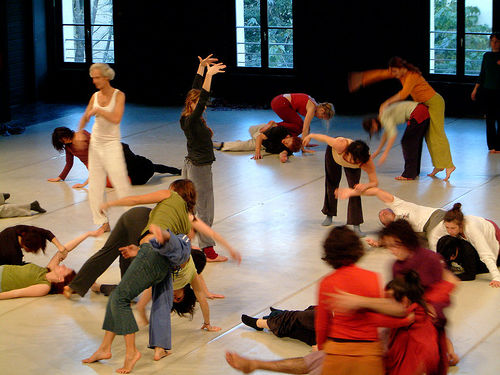Last spring, I was intrigued to read several blog posts discussing the idea of encouraging academic improvisation. Steve Fuller highlighted in his ‘Modest proposal for all future keynotes‘ that there is no point going to listen to academics who say the same things that they have said in publications. We should therefore be expecting more of them – to engage in unguarded experimentation that creates instead of repeating. Additional aspects of improvisation have been addressed in other blog posts – how it draws upon widespread reading, is linked to the non-linear creativity of writing, and might require us to practice as jazz musicians would in order to hone our skills. I find the general argument compelling, in part because improvised public speaking is not constrained by the logic of PowerPoint and has the potential to respond more intuitively to the context and participants. Fuller’s improvised plenary at the BSA Conference in April 2014 also inspired me to engage differently as a listener. Moreover, there is something about embracing the imperfections and spontaneity of ‘live’ encounters that keeps me returning to theater and music productions year after year.
But what exactly is improvisation? While general definitions point to creation with what is at hand, and without preparation, the bloggers’ comparisons with jazz musicians seemed to suggest a more specific type of improvisation based on accumulated skill and training. Years ago, I dabbled in jazz improvisation, and was also involved with improv comedy as a performer and a musician improvising live scores to long-form improvised stories. I have also watched numerous sessions of contact improvisation, a movement system of ‘spontaneous physical dialogues‘. Exposure to each of these practices highlights that they involve much more than speaking or acting ‘off the cuff’. They depend upon systems of rules and conventions that guide interactions between participants (and audiences). Improvisation is always occurring within particular contexts and structures. The question is therefore which academic structures we are seeking to escape and which we are reproducing through experiments with improvisation.
Starting from some of the principles of specific improv practices suggests what else could be gained by making improvisation a normal part of academic practice. In improv comedy, the interactions between performers are guided by basic rules that include a) don’t deny what other people say, b) there are no mistakes and c) the principle of ‘yes, and…’ wherein you always accept what others tell you as true and then build upon it. Trust is also crucial within this form and within contact improv, which adds a focus on physically supporting and giving weight to your dancing partner. When trying to imagine how these principles might apply to academic settings, it becomes clear that the keynote speech is a poor point of reference because it does not involve the same degree of interpersonal interaction as comedy or dance. Yes, academics may draw upon other authors (thanks to many hours of reading their work), but this gathering together is not the same as live discussion (e.g. round tables). Moreover, academics are regularly taught to break the ‘yes, and’ rule. Always accepting what other scholars say is a sign of weakness in a culture where critique is lauded and ‘new’, ‘innovative’ research is encouraged.
But there are many times when academics are a part of live interactions. The public exhibition I produced with colleagues last April was one such context, in which we found ourselves madly improvising when it became apparent that people were not interested in just silently reading the many posters we had prepared. PhD supervisions and group research meetings are others – and here trust, support, and embracing a sense that there are no mistakes can be crucial for the quality of ensuing results.
As much as I find the idea of improvising public lectures interesting then, I think any attempt to embed improvisation within academic practice would benefit from considering the term, its many models, and their implications in more detail. Though improvisation might be understood as something that frees the mind “from reproducing past social structures“, my experience with improv has been more often about recognizing structures and learning to play within them – realizing how jazz pianists play around with the ‘right’ and ‘wrong’ notes within any chord progression and how new audience suggestions can make the same structure of interactions play out differently (as improv games like those on Whose Line Is It Anyway illustrate). Creating new structures proceeds alongside this recognition of existing ones. The question then is not only to improvise or not improvise keynote speeches or classroom lectures, but why do we continue to prioritize keynotes and lectures in the first place? How might prioritizing trust and support in academic encounters shift our attention – for instance to kindness and slowness instead of competition and speed? What would happen to research and teaching interactions if we created more contexts reproducing ‘yes, and’ instead of ‘yes, but’?


